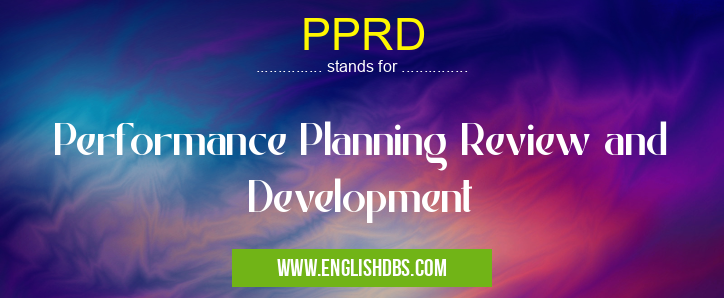What does PPRD mean in DEVELOPMENT
PPRD stands for Performance Planning Review and Development. It is a comprehensive process that helps organizations improve employee performance by setting clear goals, providing regular feedback, and identifying opportunities for growth.

PPRD meaning in Development in Community
PPRD mostly used in an acronym Development in Category Community that means Performance Planning Review and Development
Shorthand: PPRD,
Full Form: Performance Planning Review and Development
For more information of "Performance Planning Review and Development", see the section below.
» Community » Development
What is PPRD?
PPRD is a systematic approach to employee performance management. It involves:
- Planning: Establishing clear performance goals and expectations.
- Review: Assessing employee progress and providing feedback.
- Development: Identifying areas for improvement and providing support.
How does PPRD Work?
PPRD typically includes the following steps:
- Goal Setting: Managers and employees work together to set specific, measurable, achievable, relevant, and time-bound (SMART) goals.
- Regular Feedback: Managers provide employees with regular feedback on their progress towards goals.
- Development Planning: Based on feedback, managers and employees identify areas for improvement and create development plans.
- Performance Review: Employees meet with managers to discuss their overall performance, identify strengths and weaknesses, and set future goals.
Benefits of PPRD
PPRD offers numerous benefits, including:
- Improved employee performance
- Clearer communication between managers and employees
- Increased employee motivation and engagement
- Enhanced talent development
- Improved organizational alignment
Essential Questions and Answers on Performance Planning Review and Development in "COMMUNITY»DEVELOPMENT"
What is Performance Planning Review and Development (PPRD)?
PPRD is a comprehensive process that helps employees and their managers set goals, review progress, and develop skills. It aligns individual performance with organizational objectives, fostering personal growth and organizational success.
What are the key components of PPRD?
PPRD typically involves:
- Goal setting: Establishing specific, measurable, achievable, relevant, and time-bound (SMART) goals.
- Regular check-ins: Monitoring progress and providing feedback to ensure alignment with goals.
- Performance reviews: Formal assessments of performance against established goals and competencies.
- Development planning: Identifying areas for improvement and creating plans to enhance skills and knowledge.
What are the benefits of PPRD?
PPRD offers numerous benefits for both employees and organizations, including:
- Improved performance: Clear goals and regular feedback drive individual accountability and productivity.
- Enhanced motivation: Employees feel valued and supported when their performance is recognized and they are provided opportunities for growth.
- Stronger alignment: PPRD aligns individual goals with organizational objectives, ensuring that everyone is working towards a common purpose.
- Increased employee retention: Employees who feel appreciated and have opportunities for development are more likely to stay with the organization.
How often should PPRD be conducted?
The frequency of PPRD can vary based on the organization and industry. Common intervals include:
- Quarterly: For regular monitoring and feedback.
- Semi-annually: For a more in-depth review and goal adjustment.
- Annually: For formal performance assessments and development planning.
Final Words: PPRD is an essential tool for organizations that want to improve employee performance and achieve their business goals. By providing a structured framework for setting goals, providing feedback, and supporting development, PPRD helps organizations create a high-performing workforce.
